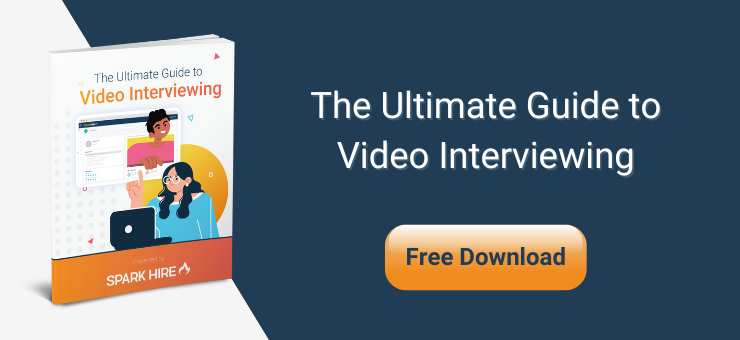You’ve heard about the impact of video interviews from other hiring professionals. Maybe you’re even ready to add them to your strategy. However, before fully committing, you need to prove to your executive team — and yourself — your investment in video interviews will be fruitful.
If you’re one of the 24% of hiring pros who don’t track cost-per-hire, like those in our How to Make the Most of Your Hiring Budget Report, it’s time to start. You’ll need this baseline to see how video interviews impact your overall hiring process.
Once you know your current cost-per-hire, you can begin measuring the impact of video interviews. Here are the metrics you need to measure to get a full grasp of your video interview ROI:
Candidate satisfaction
The candidate experience is reflective of how a company treats its people, according to a whopping 68% of candidates in a CareerBuilder survey. Nearly half of respondents in a Sterling study said they have considered dropping out of their most recent hiring experience. Since the Great Resignation, candidate expectations are higher than ever. As a result, candidate satisfaction is the top hiring process KPI.
For example, when a candidate feels their time is valued, the likelihood of following through with the hiring process increases because they don’t feel taken for granted or like they’re wasting time. Improving the candidate experience also results in applicants remaining in your talent pipeline. This decreases your team’s need to spend time and money continually bringing in massive numbers of new talent.
Proof of video interview ROI
SeatGeek was looking for a more efficient interview process. However, the hiring team wasn’t willing to sacrifice the integrity of the candidate experience. Video interviews allowed them to accelerate the process while enhancing interactions with candidates.
“We wanted to ensure that candidates were still having a great experience with SeatGeek even if they weren’t starting out on the phone with a team member,” Elizabeth Turner, Recruiting Coordinator at SeatGeek shared with us.
“So being able to personalize aspects of the process (i.e. welcome videos from the team, customizing questions specific to our company, etc.) was key to ensuring we kept our candidate experience as a priority while utilizing a video interviewing tool.”
Time-to-hire
No matter what mixture of hiring process tools you’re using, time-to-hire is a critical metric. Not only because time is money for your company but also because candidates are in a job market where opportunities seem endless.
Currently, less time passes than ever between interviews and acceptance offers. Our Growth Hiring Trends in the United States report revealed 49% of hiring pros say the norm for their time-to-hire is 7 to 14 days from receipt of an application to offer letter.
Remarkably, Talent Board’s Candidate Experience Report found 55% of candidates say they waited less than one week between their last interview and the extended offer. And their most recent report revealed that 42% of candidates don’t feel the interviewer made good use of their time.
Decreased candidate waiting time means your time-to-hire must constantly undergo improvements. Once you’ve incorporated video interviews, measure overall time-to-hire and the time you spend screening candidates, collaborating with team members, and the decreased number of hours spent performing in-person interviews solely with top talent.
Proof of video interview ROI
ORAU takes on time-sensitive projects with federal, state, local, and commercial customers to advance national priorities and serve the public interest. They’re always on the hunt for top talent, and there’s never any time to waste.
“With the busy schedule of our potential candidates and recruiters, we needed a solution that enabled our interviews to take place anytime and anywhere without sacrificing the valuable detail you receive during the interviewing process,” Michelle Goodson, Section Manager at ORAU told our team. “Using Spark Hire, we’re able to fill our requisitions in half the time.”
Offer acceptance
As an experienced hiring pro, you know extending an offer doesn’t mean you can take a breath and relax. In fact, the previously-mentioned CareerBuilder survey found 51% of employees continue looking for other jobs even when an offer has been extended, and they’re going through the background check process. Even more concerning, employers say an average of one in seven candidates (14%) walk away after they accepted an offer.
Offer acceptance is an important metric because it’s tightly tied to both your candidate experience and time-to-hire. Candidates who receive frequent communication about the hiring process and receive a quick offer are more likely to accept and follow through with the offer.
Video interviews increase your ability to improve both. In return, acceptance rates will rise. Compare the number of candidates accepting offers, and how long it takes for them to accept the offer to the number of candidates who dropped out of your process after accepting an offer before using video interviews.
Proof of video interview ROI
An Ohio-based Chick-Fil-A needed to find the best-fitting candidates for their company. They realized they were spending time on phone screens with candidates who weren’t interested in working for them.
“We have realized that the candidates who are not completing the video interviews are not genuinely interested in working for our business, so we are happy to have those candidates weed themselves out at the beginning of the interview process,” Maria Mallare, Director of People, disclosed.
“By automating the screening process…we have found a candidate is 30% more likely to stay past 90 days if they complete a video interview as part of the hiring process.”
Quality of candidates
Ultimately, the quality of candidates in your talent pipeline — and eventually in your business — are what determines your hiring success. Like most hiring pros, though, you only have a limited amount of time to assess candidates. It’s especially frustrating when you spend time with candidates during in-person interviews only to find they’re not even close to being who you need.
Video interviews broaden your potential talent pool across the globe, giving you access to more quality candidates. Additionally, they allow your team to review candidates quickly. You then have the power to spend in-person interviews with only the most fitting talent.
Proof of video interview ROI
When we sat down with Bryce Welker, CEO of Crush Empire, we were excited to hear how video interviews help the team get to know candidates on a deeper level.
“At Crush Empire, we place a lot of value in creating a strong team connection, and to do that we need to know what type of person we’re hiring,” Welker explained.
“After a resume screen, we invite candidates to a one-way video interview. With video interviews, we can gauge both an applicant’s professional background and personality, which vastly facilitates our search. The insights we get on our candidates are so complete, we have found those who make it through with a thumbs-up from their one-way interview usually get the job.”












